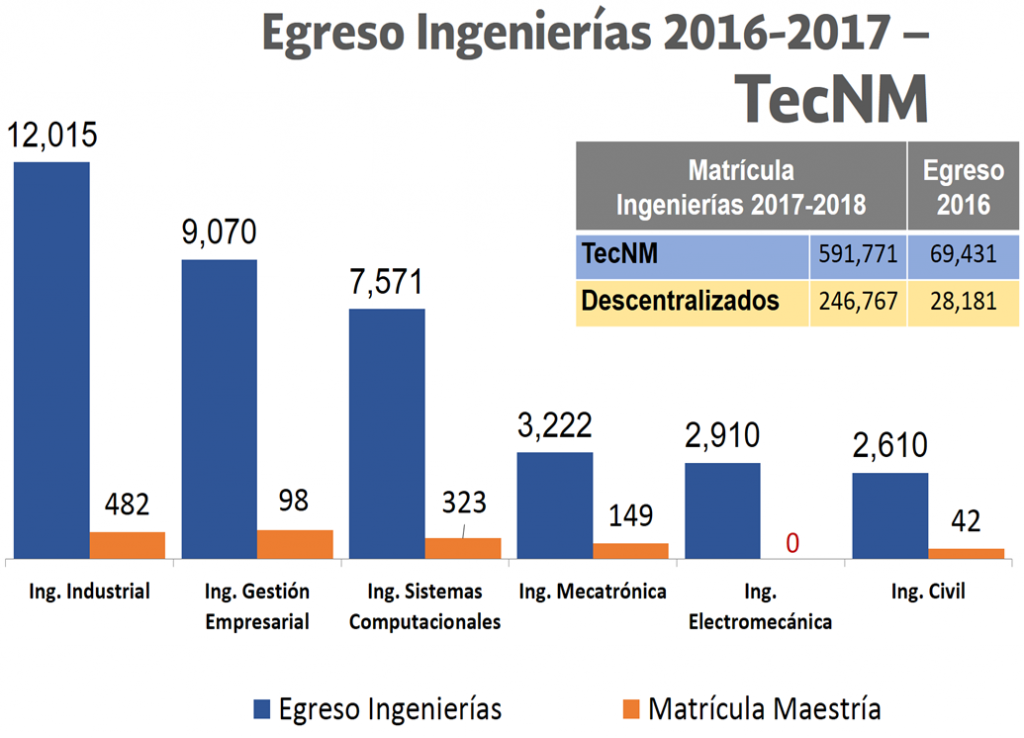By José Alberto Gaytán García *
Last week at the Tecnológico de Puebla an important national meeting of directors of the National Technological Institute of Mexico (TecNM) was held. The meeting was presided by the teacher Manuel Quintero Quintero, director of this educational system, his work crew and 266 directors of the technological institutes of the country. The main topic of the meeting was the coverage, quality and belonging to the regional development and the advances of the New Educational Model of TecNM presented by the work commissions composed by the directors of these schools.
It is important to emphasize that the Technological Institute of Mexico is the largest higher educational system in Latin America and one of the most economical and with the highest enrollment in the world. This formidable professional program is geared towards engineering careers, operates with public funds, has 266 schools, 29,000 teachers and 600,000 students. The TecNM graduates 71 thousand engineers per year and a career with the professional title included; on average, costs the student 35 thousand pesos in tuition. The same engineering career at the Tec de Monterrey costs one million two hundred thousand pesos and believe me, in academic quality there is not much difference between both programs.
The commission of plans and programs of study presented to the directors the proposal of a comprehensive postgraduate program, which aims to integrate the engineering, master’s and doctoral programs; this strategy seeks to improve the quality of our educational programs and increase the postgraduate indicators, since only five percent of the powerful annual graduation of TecNM continues its master’s studies. This condition of low participation at postgraduate level, seriously affects the research activities, teacher training and the connection with the business environment.
In the graph of engineering graduates of TecNM, it is observed that in the career of industrial engineering, with twelve thousand graduates, only five hundred study for the master’s degree and a second career of higher graduation, Engineering in business management (IGE), with nine thousand engineers a year, has a hundred students enrolled in this master’s degree. This career in the next five years will graduate 50 thousand engineers, so we must take advantage of this attractive internal market and prepare modern postgraduate programs.

Anuario Estadístico 2016-2017, ANUIES
The case of Electromechanical Engineer, although we have master’s degrees in related areas such as mechanical and electrical, does not have a postgraduate course that takes advantage of the annual output of three thousand engineers that produces this career. In Belgium, at the University of Brussels, this master’s degree is offered with specialties aimed at the mechatronics, aeronautics, construction, vehicle technologies and transport sectors, certainly these sectors are similar to the strategic sectors of the National Technological, that is, following the model of Belgium, we could offer this master’s degree and point out the specialties required in the different regions of the country.
Facing this challenge of improving the indicators of masters and doctorate, there is another challenge perhaps of greater magnitude within TecNM. I refer to the issue of improving the profile of fifteen thousand teachers who do not have a master’s degree; This amount represents 53 percent of the 28,500 permanent teachers of TecNM.
Faced with this situation and based on an international model known as “integral educational process” that articulates engineering, master’s and doctoral programs, the commission of plans and programs of studies proposed a new comprehensive graduate program, which, in five and a half years will graduate engineers with dual professional, engineering and master’s degrees. This new program, which respects the normative guidelines, is flexible, contains optional subjects and complies with the guidelines of the evaluating bodies of the Council for the Accreditation of the Teaching of Engineering (CACEI) and the National Council of Science and Technology (CONACYT). The Technological of Tepic “pilots” this proposal in biochemical engineering and the Technological of Misantla, will do the same in industrial engineering and computer systems. By August 2019, it is estimated that all technology with postgraduate programs will share this comprehensive method.
Forty-five years from the initial first graduate programs in technology in Mexico, it is an opportune time to update and improve these programs. The demand for new knowledge and technological changes that drive the world’s economy require new study scenarios. Faced with this challenge, TecNM prepares a new generation of engineers that will graduate in less time, with dual professional titles and with skills and competences that will allow them to compete successfully in the professional market of the country.
* José Alberto Gaytán García
jalbertogaytangarcia@gmail.com
Acerca del autor

- José Alberto Gaytán García ha escrito artículos y ensayos de corte académico en diarios y revistas de México y de los Estados Unidos; ha participado en importantes proyectos académicos e impartido conferencias sobre temas de historia, tecnología y educación en el marco de las relaciones entre México y los Estados Unidos, tema en el cual realizó sus estudios de doctorado en The Graduate School of Internacional Studies de la Universidad de Miami.
 Cultura General10 agosto, 2022Michio Kaku: científico del futuro
Cultura General10 agosto, 2022Michio Kaku: científico del futuro Cultura General29 junio, 2020Miguel Alcubierre: viajero de las estrellas
Cultura General29 junio, 2020Miguel Alcubierre: viajero de las estrellas Cultura General6 abril, 2020Niños brillantes (Segunda parte)
Cultura General6 abril, 2020Niños brillantes (Segunda parte) Cultura General6 abril, 2020Niños brillantes (Primera parte)
Cultura General6 abril, 2020Niños brillantes (Primera parte)







